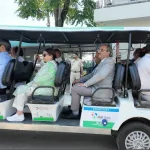It is the ability to speak and use of language to communicate, that makes humans superior to all others. Language is the cornerstone of human society and civilization. It facilitates communication, education, culture, innovation, and virtually every aspect of our lives. Recognizing the importance of language, helps us appreciate its role in shaping our world and promoting cooperation among people of diverse backgrounds and cultures. Both, learning a new language or efforts to gain deeper understanding of one’s own mother tongue have always been rewarding. It broadens the horizons; enhance the cultural understanding and opens up new opportunities.
In fact, people who know more than one language have more cognitive capabilities like improved problem solving skills, better memory, enhanced multitasking abilities etc. In addition to being rewarding, learning of a new language is also a requirement and sometimes obligation. In such a situation, we are required to find the ways and methods which help us to learn a language.
As India is celebrating 75 days of “Bharatiya Bhasha Utsav” from 28th September to 11th December, 2023, the birthday of the poet Subramania Bharati, a freedom fighter and a social reformer in Tamil Nadu, it will not be out of context to discuss about the role of technology in learning of a language. Language learning through technology has seen significant advancements and innovations in recent years. Technology has made language learning more accessible, interactive, and effective.
Today we see various Language Learning Apps which offer structured lessons, interactive exercises, and progress tracking features. Many institutions and websites offer online language courses. These courses often include video lectures, assignments, and assessments. Language Exchange Platforms like Tandem and HelloTalk and Online Language Tutor like Pre-Ply connect language learners with native speakers for language exchange. This enables learners to practice with real people.
Virtual Reality (VR) and Augmented Reality (AR) on the other hand, can immerse learners in real-life language scenarios. For example, learners can explore a virtual market where they need to communicate in the target language. Language Learning Software like Rosetta Stone offer comprehensive language learning programs that focus on listening and speaking skills. Speech Recognition and Pronunciation Tools help learners practice pronunciation and improve their accent. Machine Translation and Language Learning tools like Google Translate, and ANUVADINI can assist learners in understanding and translating text. Reading E-books and listening to Audio-books in the target language help learners build vocabulary and improve comprehension skills.
In addition to these, there are countless YouTube channels and podcasts dedicated to language learning. These are often created by native speakers and cover various aspects of language, including pronunciation, grammar, and culture. Language Learning Games, make learning fun and engaging. Social Media and Language Communities allow learners to interact with native speakers, ask questions, and share their progress. In Short, Technology has not only made language learning more accessible but also personalized the learning experience. Learners can choose the resources and methods that suit their learning style and goals, whether they want to improve their conversational skills, business communication, or fluency in a new language.
Additionally, the gamification of language learning and the ability to interact with native speakers online have made the process more engaging and enjoyable. While technology has undoubtedly made language learning more accessible and convenient, it also presents some concerns: The availability of AI-based instant language translators can lead to an overreliance on these tools, potentially discouraging people from making the effort to learn a new language. This could result in missed opportunities for cultural immersion and deeper understanding.
The use of automatic grammar correction tools can be a double-edged sword. While they can help users avoid grammar errors, they may also hinder the development of strong grammar skills. Over time, people may become dependent on these tools, making it challenging to write correctly without them. Auto spell checkers are indeed valuable for catching spelling errors, but they can also prevent users from developing strong spelling skills. Relying on spell checkers too heavily may lead to a decline in spelling proficiency.
Overreliance on technology for language correction and translation can depersonalize communication as automated tools lack the human element that makes language learning and communication more engaging and meaningful. Instant translators and correction tools may not always understand the context and nuances of language. This can result in translations or corrections that lack cultural sensitivity and may not capture the full meaning of a conversation. It is therefore better to use technology as a supplementary tool rather than the sole means of language learning.
Combining technology with traditional methods, such as speaking with native speakers, joining language classes, or traveling to countries where the language is spoken, can provide a more comprehensive language learning experience.
(The Author is Sr. Assistant Professor, Department of Information Technology, Central University of Kashmir. Feedback: [email protected])





